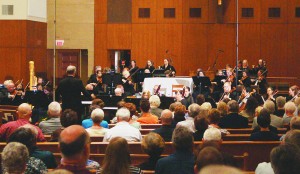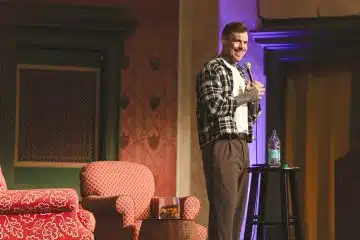World premiere of St. Maximilian Kolbe Composition at St. Max Parish
 As Paul Stanbery was composing “I Maximilian…”a piece in honor of the 75th anniversary of the martyrdom of St. Maximilian Kolbe, he felt an eerie sensation that he was being led to the various elements he used in the tribute.
As Paul Stanbery was composing “I Maximilian…”a piece in honor of the 75th anniversary of the martyrdom of St. Maximilian Kolbe, he felt an eerie sensation that he was being led to the various elements he used in the tribute.
The composition made its debut Oct. 29 on the anniversary of the saint’s namesake parish — St. Maximilian Kolbe Parish in Liberty Township. The Hamilton/Fairfield Symphony Orchestra, conducted by Stanbery played the composition with the parish’s hand bell choir.
Soloist Christopher Scott Wyatt sang the piece adapted from “De Profundis of St. Maximilian Kolbe, Prisoner 16670” by Jerzy Sito. Sito was Poet Laureate of Poland and his work is a reflection on Saint Maximilian’s martyrdom.
As Stanbery was creating the tribute, “something told me (to look into) the church bells of Kraków,” he said. “It is the second-largest city in Poland. It’s where John Paul II was archbishop. Kraków is close to Auschwitz and Maximilian’s Kolbe’s hometown is not far from Kraków. I wrote a part in the piece (with bells) and, as soon as I got that done something else said to me, ‘What about a trumpet call over the top of it?’ So, I wrote that.”
Stanbery said after including the bells, he ‘Googled’ the cathedral and discovered, “Kraków Cathedral is an ancient, 600- to 700-year-old cathedral, a beautiful place, and it turns out that the second largest church bell in the world swings and rings every day from that cathedral. So, the church bells of Kraków are part of it.”
The next concept Stanbery considered was a trumpet call. “So, I ‘Googled’ that. And, it turns out that on the hour every day a bugle or trumpet plays in the bell tower right next to the bell. The bugler or trumpeter is abruptly interrupted before he can finish because in the 1600s an army, coming in taking over Poland, shot him with an arrow and killed him before he could finish.
“The bells ring. That is in my peace and I had it written before I even found out about this stuff and what interrupts in my piece is not an arrow but the Nazis.
“When I realized what happened, I got chills,” Stanbery said. “It sounds as if someone is guiding me I like to think it was Maximilian.”
The choir’s handbell section told Stanbery “in the summertime that they have been praying for me for a year. I told them I was going to complete the piece and I wanted to tie it to the parish anniversary and have some of the music ministry involved. They had been praying for me in this process, and I like to think that affected what went on.”
Jeremy Helmes, pastoral associate for worship who helps coordinate choir and music, said the orchestra has been playing concerts at the church for several years.
“Paul had the idea of (composing a piece) for the 75th anniversary of the martyrdom and he approached me last year,” he said. “He has a Polish background. He was intrigued by Maximilian Kolbe’s story… and wanted to write something. I told him I would be overjoyed so he got to work on it… He wrote it with the intention of including hand bells partially because he wanted to replicate the sound of church bells that would’ve been heard in Poland as Kolbe was growing up as a priest and during his life.”
Stanbery noted other times when he felt a guiding hand was leading him.
“Maximilian comes out in the middle of the piece. In the entire scenario, there was a hymn that Maximilian would sing to his followers and in the starvation bunker at Auschwitz to the Immaculate Mary, which we sing.
“I also quote the Polish National Anthem to give a (location) identity to Auschwitz and Maximilian who actually lived in Warsaw. That’s where his friary was. To represent the Nazis, I used what’s called the ‘Horst Wessel’ song, a song Hitler liked a lot. The ‘Horst Wessel’ song is from a very old recording made back in the 1930s. I think no one ever wants to play that tune again because of its association with Hitler. In the iconic films the Third Reich would produce, it’s the tune playing in the background, usually a bunch of men singing in a very clipped, rugged way. That’s the ‘Horst Wessel song.
“I quote that in my music as well. I have a separate theme that shows the anxiety and an anxious Europe and anxious Poland at the time of the Nazi invasion and persecution. Underlying it all, is this inevitable death march that repeats over and over again, a subliminal thing, the inevitable thing of martyrdom.”
St. Maximilian died on Aug. 14, 1942. “When I finished the piece, I looked at the date. It was August 14. I did not know the date of his death at the time. I finished the piece on the 14th because they bumped a heart procedure I needed by a week.”
The concert also included the opening of Beethoven’s Fifth Symphony and Brahms’ Academic Festival Overture.
“I, Maximilian…” a choral and orchestral tribute to St. Maximilian Kolbe composed by Paul Stanbury and dedicated to St. Maximilian Kolbe Parish, made its world debut at the Liberty Township church last month.













